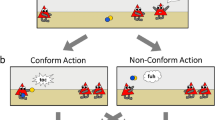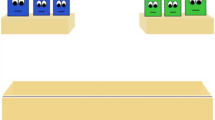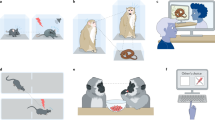Abstract
The capacity to evaluate other people is essential for navigating the social world. Humans must be able to assess the actions and intentions of the people around them, and make accurate decisions about who is friend and who is foe, who is an appropriate social partner and who is not. Indeed, all social animals benefit from the capacity to identify individual conspecifics that may help them, and to distinguish these individuals from others that may harm them. Human adults evaluate people rapidly and automatically on the basis of both behaviour and physical features1,2,3,4,5,6, but the ontogenetic origins and development of this capacity are not well understood. Here we show that 6- and 10-month-old infants take into account an individual’s actions towards others in evaluating that individual as appealing or aversive: infants prefer an individual who helps another to one who hinders another, prefer a helping individual to a neutral individual, and prefer a neutral individual to a hindering individual. These findings constitute evidence that preverbal infants assess individuals on the basis of their behaviour towards others. This capacity may serve as the foundation for moral thought and action, and its early developmental emergence supports the view that social evaluation is a biological adaptation.
This is a preview of subscription content, access via your institution
Access options
Subscribe to this journal
Receive 51 print issues and online access
$199.00 per year
only $3.90 per issue
Buy this article
- Purchase on Springer Link
- Instant access to full article PDF
Prices may be subject to local taxes which are calculated during checkout


Similar content being viewed by others
References
Langlois, J. H. Physical Appearance, Stigma, and Social Behavior: The Ontario Symposium Vol. 3 (eds Herman, C. P., Zanna, M. P. & Higgins, E. T.) (Erlbaum, Hillsdale, New Jersey, 1986)
Shepherd, J. Perceiving and Remembering Faces (eds Davies, G., Ellis, H. & Shepherd, J.) (Academic Press, San Diego, California, 1981)
Winter, L. & Uleman, J. When are social judgments made? Evidence for the spontaneousness of trait inferences. J. Pers. Soc. Psychol. 47, 237–252 (1984)
Ambady, N. & Rosenthal, R. Thin slices of expressive behavior as predictors of interpersonal consequences: A meta-analysis. Psychol. Bull. 111, 256–274 (1992)
Cunningham, W. A. et al. Separable neural components in the processing of black and white faces. Psychol. Sci. 15, 806–813 (2004)
Todorov, A., Mandisodza, A., Goren, A. & Hall, C. Inferences of competence from faces predict election outcomes. Science 308, 1623–1626 (2005)
Piaget, J. The Construction of Reality in the Child (Routledge, New York, 1954)
Repacholi, B. M. & Gopnik, A. Early reasoning about desires: Evidence from 14–18-month olds. Dev. Psychol. 33, 12–21 (1997)
Feigenson, L., Carey, S. & Spelke, E. S. Infants’ discrimination of number vs continuous extent. Cognit. Psychol. 44, 33–66 (2002)
Hamlin, J. K., Hallinan, E. V. & Woodward, A. L. Do as I do: 7-month-old infants selectively reproduce others’ goals. Dev. Sci. (in the press)
Cheries, E., Mitroff, S. R., Wynn, K. & Scholl, B. J. Cohesion as a principle of object persistence in infancy. Dev. Sci. (in the press)
Woodward, A. L. Infants selectively encode the goal object of an actor’s reach. Cognition 69, 1–34 (1998)
Premack, D. & Premack, A. J. Infants attribute value ± to the goal-directed actions of self-propelled objects. J. Cogn. Neurosci. 9, 848–856 (1997)
Gergely, G., Nadasdy, Z., Csibra, G. & Biro, S. Taking the intentional stance at 12 months of age. Cognition 56, 165–193 (1995)
Kuhlmeier, V., Wynn, K. & Bloom, P. Attribution of dispositional states by 12-month-olds. Psychol. Sci. 14, 402–408 (2003)
Kuhlmeier, V., Wynn, K. & Bloom, P. Reasoning about present dispositions based on past interactions (International Conference on Infant Studies, Chicago, Illinois, 5 May 2004)
Kelley, D. et al. 3-month-olds, but not newborns, prefer own-race faces. Dev. Sci. 8, F31–F36 (2005)
Slater, A. et al. Newborn infants prefer attractive faces. Infant Behav. Dev. 21, 345–354 (1998)
Warneken, F. & Tomasello, M. Altruistic helping in human infants and young chimpanzees. Science 311, 1301–1303 (2006)
Trivers, R. L. The evolution of reciprocal altruism. Q. Rev. Biol. 46, 35–57 (1971)
Axelrod, R. The Evolution of Cooperation (Basic Books, New York, 1984)
Haidt, J. & Joseph, C. Intuitive ethics: How innately prepared intuitions generate culturally variable virtues. Daedalus 133, 55–66 (2004)
Pinker, S. The Blank Slate (Norton, New York, 2002)
Hauser, M. Moral Minds (Ecco, New York, 2006)
Acknowledgements
We thank A. Norman, J. Stitelman, E. Madva, K. McCrink, G. Newman and E. Cheries for their assistance and input. This work was supported in part by a National Science Foundation grant to K.W.
Author information
Authors and Affiliations
Corresponding authors
Supplementary information
Supplementary Video 1
This file contains Supplementary Video 1. This movie shows the Helper habituation event in Experiments 1 and 3, in which the Climber attempts but fails to get up the hill and is helped to the top by the Helper (in this case the yellow triangle). (MOV 231 kb)
Supplementary Video 2
This file contains Supplementary Video 2. This movie shows the Hinderer habituation event in Experiments 1 and 3, in which the Climber attempts but fails to get up the hill and is pushed to the bottom by the Hinderer (in this case the blue square). (MOV 235 kb)
Supplementary Video 3
This file contains Supplementary Video 3. This movie shows the test event in Experiments 1 and 3 in which the Climber looks around and moves to sit next to the yellow triangle. (MOV 94 kb)
Supplementary Video 4
This file contains Supplementary Video 4. This movie shows the test event in Experiments 1 and 3 in which the Climber looks around and moves to sit next to the blue square. (MOV 104 kb)
Supplementary Video 5
This file contains Supplementary Video 5. This movie shows the Pushing Up habituation event in Experiment 2, in which an inanimate circle rests at the bottom of the hill before being pushed to the top by the Pusher-Upper (in this case the blue square). (MOV 653 kb)
Supplementary Video 6
Supplementary Video 6. This movie shows the Pushing Down habituation event in Experiment 2, in which an inanimate circle rests at the top of the hill before being pushed down to the bottom by the Pusher-Downer (in this case the yellow triangle). (MOV 723 kb)
Supplementary Video 7
This file contains Supplementary Video 7. This movie shows the Neutral habituation event that is paired with the Helper event (shown in Supplementary Video 1) in the Helper/Neutral condition of Experiment 3. The Neutral character comes onto the screen and dances up the hill while the Climber rests at the bottom, performing identical physical motions to the Helper, but not affecting the Climber in any way. (MOV 135 kb)
Supplementary Video 8
This file contains Supplementary Video 8. This movie shows the Neutral habituation event that is paired with the Hinderer event (shown in Supplementary Video 2) in the Hinderer/Neutral condition of Experiment 3. The Neutral character comes onto the screen and dances down the hill while the Climber rests at the bottom, performing identical physical motions to the Hinderer, but not affecting the Climber in any way. (MOV 106 kb)
Rights and permissions
About this article
Cite this article
Hamlin, J., Wynn, K. & Bloom, P. Social evaluation by preverbal infants. Nature 450, 557–559 (2007). https://doi.org/10.1038/nature06288
Received:
Accepted:
Issue Date:
DOI: https://doi.org/10.1038/nature06288
This article is cited by
-
Beyond behavior: the penitence congruity effect among children
Current Psychology (2024)
-
Relational visual representations underlie human social interaction recognition
Nature Communications (2023)
-
The cognitive challenges of cooperation in human and nonhuman animals
Nature Reviews Psychology (2023)
-
Joint reasoning about social affiliation and emotion
Nature Reviews Psychology (2023)
-
Age-dependent changes in intuitive and deliberative cooperation
Scientific Reports (2023)
Comments
By submitting a comment you agree to abide by our Terms and Community Guidelines. If you find something abusive or that does not comply with our terms or guidelines please flag it as inappropriate.



